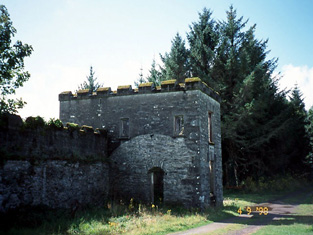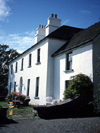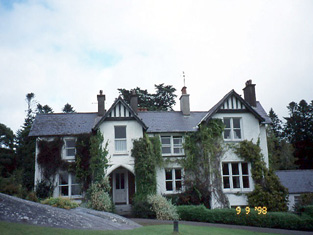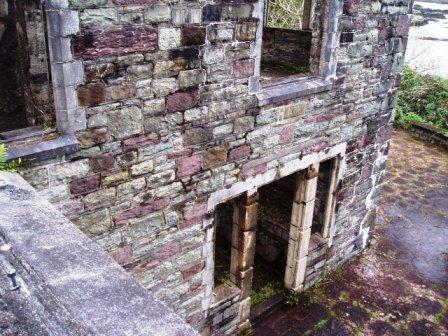Hollywood
Houses within 15km of this house
Displaying 15 houses.
Houses within 15km of Hollywood
Displaying 15 houses.
| House name | Description | |
|---|---|---|
| Derryquin Castle | At the time of Griffith’s Valuation James F. Bland was leasing a property valued at £29 at Derryquin, from the Guinness estate. Lewis, in 1837, and Leet, in 1814, record the house as the seat of Francis C. Bland . The property was eventually sold by the Blands to the Warden family. In 1906 it was owned by Col. Charles W. Warden and valued at £70. The Wardens resided there until it was burnt in 1922. It was located in the grounds of what is now the Parknasilla Hotel but the ruins were demolished in 1969. See www.parknasillahotel.ie for e-book on the history of this property. |

|
| Parknasilla | James F. Bland was leasing a house valued at £10 to Christopher Bland at the time of Griffith’s Valuation. Bary states that some historians believe this to be the original Bland house in the area. In the mid 19th century it became known as the Bishop’s House as it was leased by the Bland estate to Bishop Graves of Limerick. Later still it became the forerunner of the Parknasilla hotel, in which grounds it is still located. A second house in the townland is labelled Clashnacree House [V721649] on the 25-inch Ordnance Survey map of the 1890s. In 1894 Slater records this latter house as the seat of J.F. Fuller. It is still extant. | |
| West Cove | Edward J. Hartopp was leasing this property at Coad, valued at £14 15s, to Eugene O’Sullivan at the time of Griffith’s Valuation. Lewis mentions Castle Cove as the residence of Mr. O'Sullivan in 1837 but he may have meant this house. In 1814, Leet noted Cooe as the seat of John Sesggerson and Bary states that, prior to the O'Sullivan occupation, West Cove was the seat of the Seggerson family. It is still extant and sometimes let as holiday accommodation. |

|
| Drimna House | James F. Bland was leasing a house valued at £7 to Rev. Arthur Watson at the time of Griffith’s Valuation. In 1906 Col. Charles W. Warden owned a property at Drimnamore, valued at £3 10s. It is still extant. | |
| Scart | James F. Bland was leasing a house valued at £10 15s to William Jermyn at the time of Griffith’s Valuation. Bary states that Scart house was occupied for several generations of the Jermyn family before being sold in the 1890s. It is still extant and occupied. |

|
| Castle Cove | Thomas Jermyn was leasing a house valued at £10 10s to John Jermyn at the time of Griffith’s Valuation. Lewis describes Castle Cove as the seat of Mr. O'Sullivan in 1837 though he may have been referring to West Cove House. Leet, in 1814, mentions "Cooe Castle" as the seat of David Jermyn, Bary notes that Castle Cove was in the possession of the Jermyn family in the nineteenth century. They were agents for the Bland estate. It is no longer extant. | |
| Liss Cottage | James F. Bland was leasing a house valued at £5 to David Jermyn at the time of Griffith’s Valuation. This appears to be Liss Cottage, which Bary states was a residence of the Jermyn family for a long time. There is still a house at this site though it may have been altered. | |
| Coomlumminy Court | The representatives of Reverend D. Mahony were occupying a house valued at almost £5, together with over 1400 acres at the time of Griffith’s Valuation. In 1906 this was the property of Mary Mahony and valued at £3. The building was labelled Coomlumminy Court on the 1st and subsequent edition Ordnance Suvey maps and is now a ruin. | |
| Dromore Castle | The reps of Rev. D. Mahony were occupying a property valued at £66, at the time of Griffith’s Valuation. Lewis mentions " a noble edifice in the Gothic castellated style" as the seat of Rev. Denis Mahony in 1837. In 1814, Leet noted Dromore as the seat of John Mahony. In 1906 it was owned by H.S. Mahony and valued at £66 15s. Bary states that it was built by Sir Thomas Deane for Rev. Denis Mahony in the 1830s. It remained in the Mahony family until the early years of the twentieth century. It then passed by marriage to the Hood family. The Irish Tourist Association survey in 1943 indicates it was the property of Colonel E. Hood whose wife was "the last of the O'Mahonys, a family associated with the area for over 300 years". It later pass from them to the Wallers, cousins of the Hoods. Dromore Castle is still extant and the National Inventory of Architectural Heritage states that it was renovated in 1998. |

|
| Old Dromore House | The representatives of Rev. D. Mahony were leasing a house valued at £25 to James McClure at the time of Griffith’s Valuation. The McClures were the agents for the Mahony estate for many years. It is labelled "Dromore Old" on the 1st edition Ordnance Survey map and as "Old Dromore House" on the later 25-inch edition of the 1890s. Bary states that it was the original Mahony house before the building of Dromore Castle. It is not extant now. | |
| Derreen | Peter McSweeney was leasing the property at Derreen from the Lansdowne estate at the time of Griffith's Valuation, when it was valued at £6 10s. Lewis also notes it as his residence in 1837. Bary states that Derreen was originally built by a branch of the O'Sullivans from whom it passed to Peter McSweeney who was married to a member of that family. It formed part of the Lansdowne estate and later came into the possession of the Petty-Fitzmaurices. In 1906 it was owned by that estate and was valued at £53 15. It was burnt in the early 1920s but rebuilt in the same style and is still extant and occupied. It is famous for its beautiful gardens. |

|
| Gearha | In 1906 Mary Mahony owned this property valued at £4 5s. At the time of Griffith's Valuation, Frederick Hyde was leasing it from the Mahony estate when it was valued at £2 5s. Buildings are still extant at the site. | |
| Rossdohan | In 1906, Samuel T. Heard, MD, owned this property at Rossdohan, barony of Dunkerron South, when it was valued at £27. Bary states that this house was built in 1875 by Thomas Heard, a surgeon who had retired from India. He died in the early 1920s and the house was burned around that time. There are remains of a later house still visible on the island. |

|
| Clodragh or Derriana Lodge | Part of the Mahony estate at the time of Griffith's Valuation when it was held in fee by Daniel Mahony and valued at almost £2. Bought by the Williams family in the late 1850s following the sale of the Mahony estate, the lodge seems to have become known as Derriana Lodge by the end of the nineteenth century. There are still buildings at this site. | |
| Oak Lodge (Bear) | Leased by Robert Puxley from John L. Puxley at the time of Griffith's Valuation, when it was valued at £6. In 1906 it was the property of Henry L. Puxley and valued at almost £9. There is still an occupied house at the site. |

